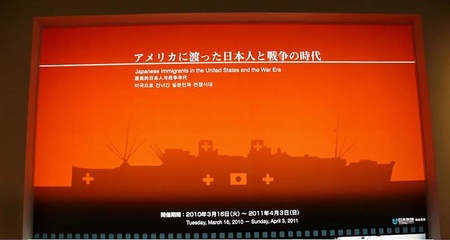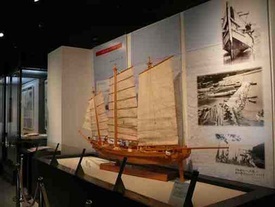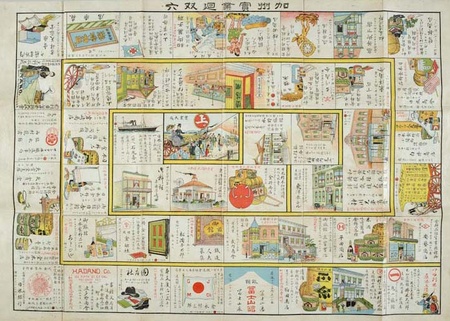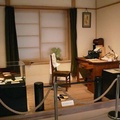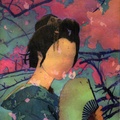Introduction
The exhibit entitled Japanese Immigrants in the United States and the War Era at the National Museum of Japanese History, Chiba, Japan closed on April 3, 2011 after a year-long opening to the public. It was a special exhibit to commemorate the opening of the Sixth Exhibit Room of the museum in March 2010, which displays contemporary history. Some might think that this national museum mainly focuses on Japanese history, meaning events that took place in Japan. However, this project was designed to shed light on “the views of people living as others,” including the Issei, who went to the U.S. from Japan. The term “others” in this context means people who lived in another country either as immigrants or residents, excluding Americans living in the U.S. and Japanese living in Japan. This was not clear to me until I saw the exhibit.
Since I had lived in Hawaii for a decade and had had contact with the Japanese community there, my curiosity made me decide to visit to see the historic exhibit about Japanese Americans, which was about to close. This was reason enough to bring me to Chiba, even though it was only about 200 km away from the Fukushima Power plant and it had only been a couple of weeks after the gigantic earthquake, tsunami and nuclear power plant disaster that occurred on March 11. Luckily, I was able to travel to Chiba smoothly enough, and both the collection manager, Mr. Nagatsuka, and the curator, Dr. Harayama, of the exhibit welcomed me.
In the entrance to the exhibition, the front exhibit title board immediately caught my attention. It showed a big ship-shaped shadow over a red-orange screen. The color red represented wartime and the shape of the ship hinted at the fact that general transportation at that time was only big ships for migration (Photo 1). Later in the exhibit, I learned that the shadow was of a type of ship called koukan-sen, war repatriation ships, operated to transport all captured persons from one place to another. Therefore, Japanese people who were in the U.S. boarded the ship to go back to Japan in wartime. More than that, my impression of the opening of this exhibit was that the repatriation ships were the key elements of the story in wartime. In the following four sections, I will introduce the main concepts of the exhibition, which emphasized people who were moving between countries, by examining the displayed materials and the metaphoric use of ships. In the conclusion, I will discuss what this exhibit proposes to the Japanese people in terms of a new interpretation of history.
Section 1: The Two Sides of the Story
To begin with the four major sections of the exhibit in chronological order, the first section, entitled “People on the Move,” represented the two sides of the story of how migration began, with the events shown in a parallel display to compare the social and economic situations in the two countries. One side was about the beginning of the Japanese migration in Japan, and the other side was about the settlement of Japanese immigrants in the U.S. This section represented the causes and effects of the movement in general — how they left and how they settled.
Notably, Yawatahama Village in Ehime prefecture was introduced as “The Birthplace of Japanese Immigrants.” To show the history of migration, there were many specimens related to the immigrants from the village: a couple of hats and suitcases that were brought from the U.S.; a record of a kou or communal Buddhist service for family members left behind, held in hopes that the departed villagers would bring back their success from the U.S.; a couple of enlarged copies of a record of an investigation of smuggling, and a model of a ship used for smuggling from the 1880s to the 1920s.
Among these, the most striking for me was a model of a ship called utase-bune (fishing ship) (Photo 2: 1/15 model of actual ship). According to the exhibit text, this ship was used mainly for fishing, so it was not designed to sail for a long distance. But many people from Yawatahama Village crossed the Pacific Ocean to the west coast of the United States in this type of fishing ship. In some cases, they were captured and sent back to Japan or passed away on the ship.
One factor in the success of the adventure was enthusiastic encouragement for migration. Some former villagers who had lived in the U.S. came back to the village and told their success stories, and occasionally recruited some laborers for their business on the mainland1. They often sent money to build schools in the villages. To explain the migration fever, the exhibit also shows a record of investigations of smugglers, with an enlarged copy as a hands-on display.
The opposite side of the display showed an immigrant settlement in Seattle, as an example of their lives in North America. There were many photos showing the transition of Japanese immigrants in many different types of clothes with other ethnic groups, hand-drawn maps of Japanese villages in Port Blakely, Bainbridge Island, Washington made by former settlers, and various advertisements inviting Japanese to be workers, students, or picture brides. One type of advertisement was unfamiliar to me until I saw it at the exhibit. This was a guidebook called "Independent and Self-sufficient Life —Studying Abroad in North America"2 promoting examples of ideal life and mentioning the “luxury of being a schoolboy."
A significant exhibit representing the immigrants’ dream was a colorful business sugoroku game that was drawn by immigrants in California. The game consists of many pictures with advertisements of Japanese business in California. In the center, the goal of the game, there are two goals selectable by the player: success in America or returning back to one's hometown with wealth. These goals represented the two dreams of the Issei at that time (1904) (Photo3)3. This section showed that, beginning in the 1880s, there was a wave of immigration to the U.S., and it displayed related specimens showing how large numbers of people decided to settle in the U.S to seek greater opportunities there.
Notes:
1. The exhibit introduced the case of Kyuhachi Nishii, owner of a restaurant and factory in Tacoma, Washington, who once went back to the village in 1899 to recruit labor.
2. 1903 Daijiro Yoshimura, Okajima Shoten (The English title is used by the author for convenience). Collection of The National Museum of Japanese History.
3. Kashu Jistsugyo Sugoroku (California Business Sugoroku) is in the collection of National Museum of Japanese History.
© 2011 Kaori Akiyama


